|
Social News
6/4 (Hourly Updated)
Moc Chau Tea Festival opens
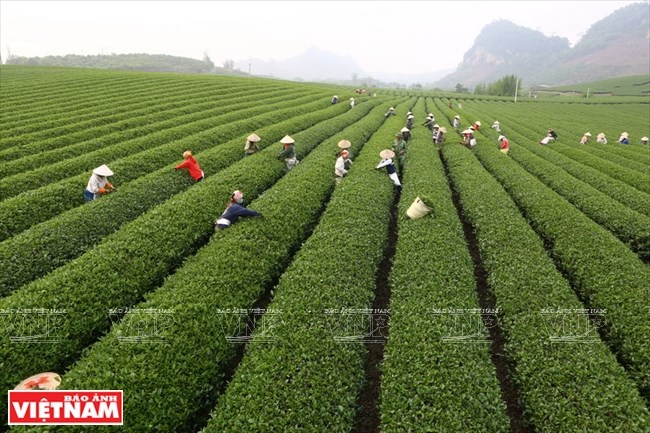
Farmers work on vast tea hills in Moc Chau, Son La.
The
third edition of the Moc Chau Tea Festival began on April 6 at Vinatea Moc
Chau, a member of the Vietnam National Tea Corporation (Vinatea), in northern
Son La province, bringing together six local tea producers.
The
festival will feature a wide variety of events, including art performances, a
tea-leaf picking contest, a tea ceremony and exhibitions of tea products and
photos of tea plantations in Moc Chau. The geographical indication for Snow
Shan (Shan Tuyet) tea of Moc Chau in Thailand will be announced during the
festival.
The
organiser will also hold sight-seeing tours around Moc Chau vast tea hills
and tea production for visitors and a ceremony to mark the 60th anniversary
of the national Moc Chau tea plantation which was founded on April 8, 1958.
The
festival aims to promote Moc Chau tea products, provide a platform for tea
producers and traders to meet and foster safe and clean tea-making, said
Nguyen Thi Hoa, Vice Chairman of the People’s Committee of Moc Chau district.
It
is also an opportunity for the district to attract more visitors and draw
investors’ attention. Tea businesses and cooperatives are expected to form
partnerships during the event, she added.
Moc
Chau is endowed with a cool climate and soil suitable for growing tea
plants.
Formed
in 1959, the Moc Chau tea area now stretches across some 1,800 hectares and
produces more than 23,000 tonnes of tea leaves annually. Moc Chau tea
products are exported to many international markets, including Japan, Taiwan
(China) and Pakistan. In recent years, the production of tea in Moc Chau has
also boosted local tourism.-
“Vietnam Day” promotes Vietnam-Russia culture exchange
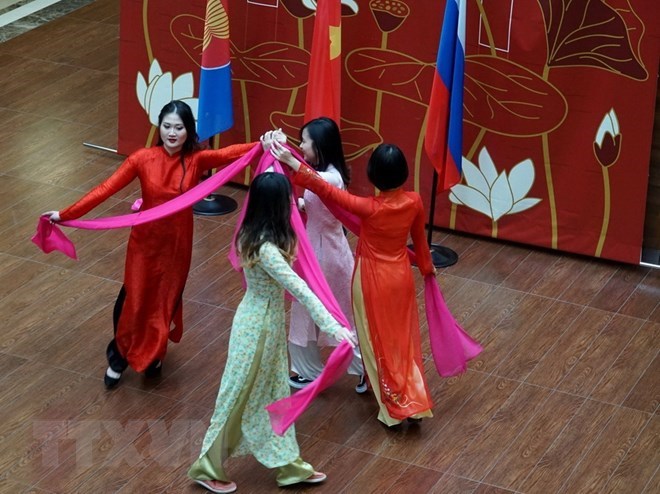
Art
performance at the event
The
4th “Vietnam Day” programme was held in the Moscow State Institute of
International Relations University (MGIMO) on April 5, showcasing Vietnamese
culture and food to Russian friends.
Speaking
at the event, Egor Andreev from the MGIMO affirmed the event has become a
useful playground for Russian students who are learning Vietnamese language
and culture.
He
said 327 Vietnamese students graduated from the MGIMO over the last six
decades, and many of them became senior officials and diplomats in
Vietnam.
Educational
cooperation between Vietnam and Russia has contributed to helping the two
countries improve the quality of human resources, thus fostering bilateral
relations.
Nguyen
Thi Kim Thu from the Vietnamese Embassy in Russia highlighted the
significance of the event’s theme, “The youth of the 21st century”, saying
that it helps promote friendship and cultural respect.
In
the framework of the event, a seminar discussing the role played by young
people in reinforcing Russia-Vietnam relations was held.
Participants
also debated global challenges to Vietnamese youths and Russia-Vietnam
cooperation, and the role of youths in the Fourth Industrial Revolution in
the two countries.
Taste of Australia features various activities
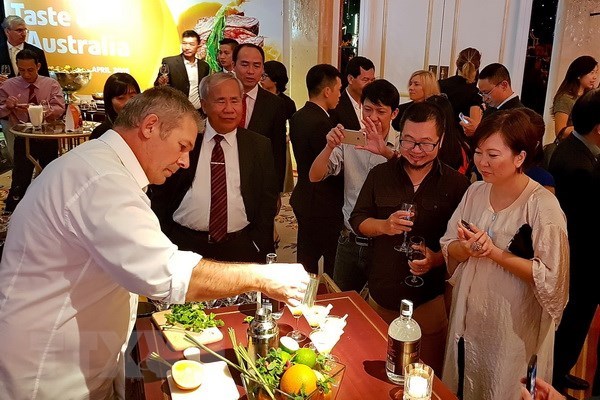
Visitors
enjoy beverages at the event
The
Consulate General of Australia in Ho Chi Minh City hosted a programme called
“Taste of Australia” on April 5 as part of activities to celebrate the 45th
founding anniversary of diplomatic ties between the two countries.
The
annual event aims to introduce and promote Australian food, beverages,
cuisine, and culture, and the country’s world-class chef training field. For
the first time Australian music would be a focus of the programme.
The
musical events include music and wine pairing in HCM City, and the central
cities of Da Nang and Hue with Australian artists and classical pianist Van
Anh Nguyen, a performance by singer-songwriter Nick Barkerm, and an
appearance by singer Deni Hines.
Mark
Coulton, Assistant Minister for Trade, Tourism and Investment of Australia,
said the two nations have elevated the bilateral relationship to the level of
strategic partnership, opening up great opportunities to further develop
trade ties.
Meanwhile,
Australian Ambassador to Vietnam Craig Chittick said the event creates a
unique chance for attendees to enjoy both Australian nice music and
food.
Addressing
the event, Vice Chairman of the municipal People’s Committee Le Thanh Liem
stressed Vietnam-Australia diplomatic ties have developed constantly and
obtained remarkable achievements in different fields from politics, trade,
investment, education, defence to development cooperation.
“Taste
of Australia” offers a good chance for people in the city, and in Vietnam in
general to have interesting experiences with Australian cultural identity, he
said.
Preparations made for Vietnamese Catholics’ seventh national
congress
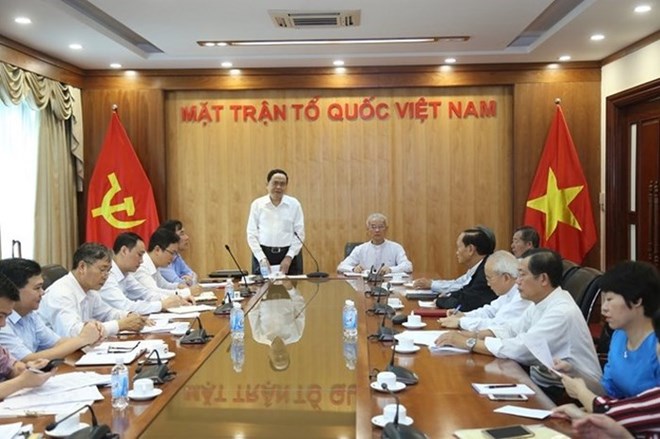
At the
meeting
The
seventh national Congress of Vietnamese Catholics building and protecting the
homeland for the 2018-2023 tenure is planned to take place in Hanoi on
October 17-18.
Preparations
for the event were discussed at a meeting between the Standing Board of the
Vietnam Fatherland Front Central Committee and the Standing Board of the
Committee for Solidarity of Vietnamese Catholics in Hanoi on April 5.
Catholics
in 21 cities and provinces have organized their congresses while those in
nine other provinces had conferences to review their five-year activities and
12 others will hold their congresses, as preparatory steps for their seventh
national congress.
Priest
Tran Xuan Manh, Acting Chairman and Secretary General of the Committee for
Solidarity of Vietnamese Catholics affirmed that the Committee is working
hard to prepare for the event.
President
of the Vietnam Fatherland Front Central Committee Tran Thanh Man asked the
front units to provide maximal assistance for the Committee for Solidarity of
Vietnamese Catholics to ensure the congress will be successful.
He
said he believes that via the congress, the social role and prestige of the
Committee will be heightened to bridge the State and the Church and enhance
the Church’s companion with the nation.
Green public procurement benefits economy, society: workshop
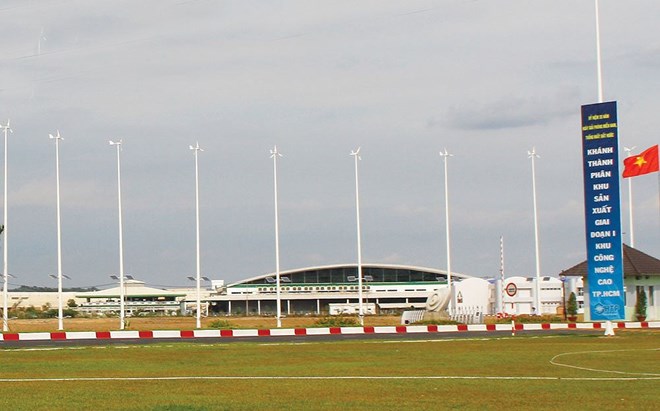
Green
public procurement will bring many benefits to not only buyers and sellers but
also the environment and the whole economy and society (Illustrative photo:
baodauthau.vn)
Green
public procurement will bring many benefits to not only buyers and sellers
but also the environment and the whole economy and society, said Deputy
Director General of the Vietnam Environment Administration (VEA) Hoang Van
Thuc said.
He
made the remark at a workshop on April 5 which discussed challenges and
opportunities of green public procurement in Vietnam.
A
2015 report of the VEA under the Ministry of Natural Resources and
Environment shows that the State spends 20 – 30 percent of its budget on
public procurement every year on average. This figure could reach 50 percent
if it includes spending on the building work.
Amid
economic restructuring towards sustainable development, sustainable
procurement will considerably contribute to the attainment of the sustainable
development goals, including improving production quality, effectively and
sustainably using natural resources, and ensuring security and social equality.
Kim
Yong Jin, Director of the Republic of Korea’s Environmental Industry and
Technology Institute, said Vietnam is a developing Asian-Pacific economy with
a growth rate of 5 – 7 percent in the last 10 years.
Realising
the problems of traditional modes of economic growth, Vietnam announced a
green growth strategy and is building a road map for implementing green
public procurement until 2020.
He
added as public procurement could be equivalent to 12 – 30 percent of the
country’s GDP, the procurement of environmentally friendly products will help
reduce pollution and promote green production and sustainable consumption.
However,
Deputy Director General Thuc also pointed to hindrances to green public
procurement, including the inconsistency of legal documents which has led to
State agencies’ lax coordination, the limited awareness and capacity of
procurement officials, and the shortage of guidance on integrating
sustainability criteria into the bidding process.
Notably,
awareness of the positive impacts of sustainable public procurement among
State agencies and procurement officials remains modest, he noted.
He
underscored the importance of training courses for these officials, adding
that it is a priority in the VEA’s cooperation with the Korean institute. The
countries’ sharing of information about and experience in this field will be
helpful for carrying out green public procurement in Vietnam.
Acecook Vietnam becomes gold sponsor of Hue Festival 2018
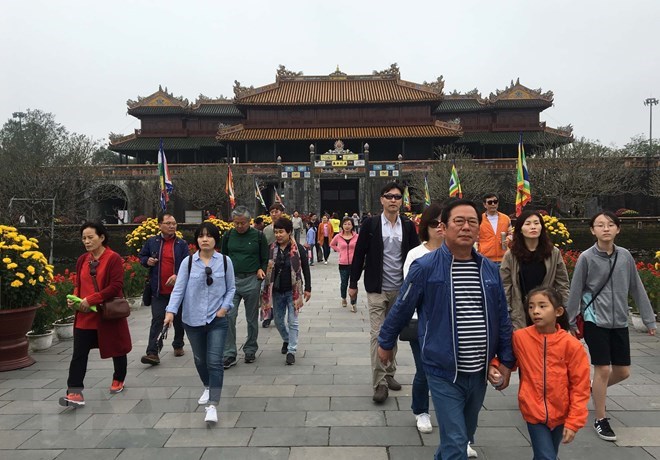
The
Acecook Vietnam JSC will fund 3.3 billion VND (144,800 USD) for Hue Festival
2018, becoming a gold sponsor for the event scheduled for April 27 – May
2.
The
signing ceremony took place in the central province of Thua Thien-Hue on
April 4.
Speaking
at the event, General Director of Acecook Vietnam Kajiwwara Junichi said the
company is honour to support the event, adding that over the past 23 years,
it has strived to maintain the value of traditional cuisine by combining
Vietnamese flavour with Japanese technology.
Themed
“Cultural Heritage with Integration and Development: Hue - One Destination,
Five World Heritages”, the biennial event aims to promote art exchanges among
cultures and introducing unique values of the culture of Vietnam and Hue,
thus boosting service-tourism growth and strengthening socio-economic
development of Thua Thien-Hue.
So
far, the Hue Festival 2018 has attracted more than 20 international art
troupes from various countries, including France, the Republic of Korea,
Israel, Mongolia, Japan, Thailand, Russia, China and Spain.
The
old capital city of Hue owns five UNESCO heritages, including Hue Complex of Monuments,
Hue Royal Court Music, Woodblocks of Nguyen Dynasty (1802-1945), Nguyen
Dynasty's royal documents and the royal literature on Hue royal architecture.
As
Hue served as the imperial city under the Nguyen Dynasty (1802-1945), the
festival will reenact royal celebrations and events such as Royal Night,
Orient Legends and the Nam Giao ritual.
In
addition, many side events will be held, such as the Hue Science Festival
(organised by the Hue College of Medicine and Pharmacy), International
Gastronomy Fair, beer carnival, International Trade Fair, Splendid Taste of
Ancient Village in Phuoc Tich, traditional boat race on Huong (Perfume)
River, kite festival, Tam Giang Lagoon Fantasy and Hue Poetry Festival.
Exhibitions
taking different themes include ‘the poetry on Hue royal architectural works
inscribed on truc chi (bamboo pulp) paper’, ‘colours of Bat Trang pottery’,
‘orchids and bonsai’, ‘old car exhibition’ and ‘cultural heritage with
integration and development’.
Various
sight-seeing tours offer more fantastic journeys to discover local
attractions such as Lang Co beach and Tam Giang Lagoon.
Hue
Festival has taken place every two years starting from 2000, bringing
together excellent arts companies with unique performances from across the
world.
This
year, the province hopes to welcome about 4.2 million visitors, up 10 percent
year on year, and earn tourism revenue of 4.2 billion VND, a rise of 15
percent.
Tien Giang develops offshore fishing fleet
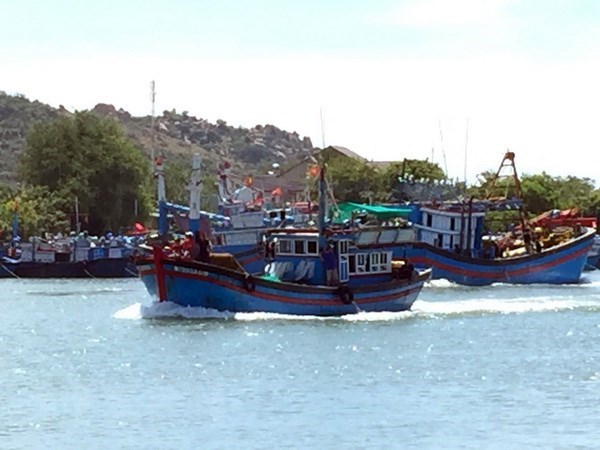
The
southern province of Tien Giang has developed a fleet of offshore fishing
vessels in order to create jobs for workers at sea and affirm sea and island
sovereignty.
With
a coastline of 32km, Tien Giang is home to localities with long tradition in
fishing such as Go Cong township, Go Cong Dong and Tan Phu Dong districts and
My Tho city, attracting tens of thousands of skilled workers.
Other
industries such as seafood processing, aquatic products and dried seafood
also contributed to boosting local economic growth and ensuring social
welfare.
In
order to sustainably tap aquatic products, the province has encouraged
building high-capacity vessels equipped with modern technology and capable of
going fishing offshore.
Infrastructure
for fishing logistics services such as ports and storm-proof wharves have
also been upgraded. Two of its ports, My Tho and Vam Lang, are among national
fishing ports.
Last
year, the province dealt with more than 260 petitions asking for support from
fishermen.
Traditional
fishing grounds of local fishermen include the Truong Sa archipelago, DK1
platform, and west sea area.
This
year, the province strives to tap more than 102,000 tonnes of fish and
shrimps.
National blood centre set up to ensure supplies for patients

At the
ceremony to announce the establishment of the national blood centre (Photo:
dantri.com.vn)
The
National Institute of Haematology and Blood Transfusion (NIHBT) on April 4
announced the Ministry of Health’s decision to set up a national blood centre
under the institute.
Director
of the institute Bach Quoc Khanh said that the centre, equipped with modern
technology and high profession will support the development of blood
transfusion sector in the country.
It
also creates a premise to set up a national blood centre under the Ministry
of Health, he added.
Carrying
out the World Bank’s Regional Blood Transfusion Centres Project, the
institute built a modern transfusion blood centre with capacity of 90,000
blood units per year. Particularly, the institute received 303,462 blood
units in 2017 and the number is expected to increase to 600,000 units by
2030.
The
centre is established to organise blood transfusion and reserve blood for
national security.
NIHBT
Deputy Director Pham Tuan Duong is assigned as the director of the blood
centre.
Quang Ngai tightens control of fishing activities to fight IUU
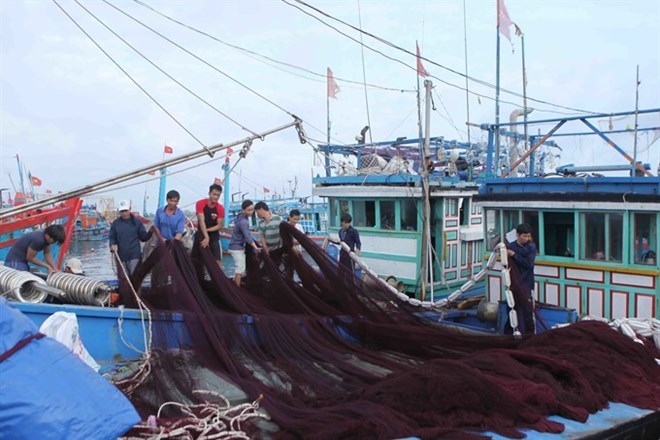
Fishermen
of An Hai commune in Ly Son island district in the central province of Quang
Ngai prepare for a fishing trip.
The
central province of Quang Ngai has set up two offices to monitor and inspect
activities of fishing vessels at sea as part of local efforts to stop
illegal, unreported and unregulated (IUU) fishing.
The
two offices are based at Tinh Ky fishing port (Tinh Ky commune) and Tinh Hoa
port (Tinh Hoa commune in Quang Ngai city). The offices’ staff will conduct
inspection of fishing vessels coming in or leaving the ports. The staff will
also inspect and certify the origin of catches.
According
to Duong Van To, director of the provincial Department of Agriculture and
Rural Development, the department will set up inspection offices at all
fishing ports in the province with the aim of preventing local ships from
involving in illegal fishing and facilitating the management and
certification of seafood origin in line with regulations.
In
September 2017, the EC issued a yellow card warning Vietnam for failing to
progress in fighting IUU fishing. The EC also proposed nine recommendations
that Vietnam should implement. The "yellow card" is followed by a
"green card" if the problem is resolved or a "red card"
if it isn’t. A “red card” can lead to a trade ban on fishery products.
The
EU will assess Vietnam’s efforts to fight IUU fishing in April.
On
December 13, 2017, Prime Minister Nguyen Xuan Phuc issued Directive 45/CT-TTg
on some urgent tasks and solutions following the EC’s warning.
The
whole political system, from the central to local level, and fishermen of
Vietnam have taken drastic actions to prevent and combat IUU fishing.
There
have been an array of urgent solutions, including supplementing anti-IUU
fishing regulations to legal documents, enforcing the issued regulations,
disseminating the solutions to fishermen and relevant parties, enhancing
cooperation with coastal and island countries to prevent IUU fishing, and
holding dialogues to update the EU on Vietnam’s efforts to improve fisheries
management.
As
a result, illegal fishing in foreign waters by Vietnamese boats has declined
considerably, the Ministry of Agriculture and Rural Development (MARD) said
at the ministry’s regular press conference on March 2.
Foreign-funded projects help Quang Tri deal with unexploded
ordnance
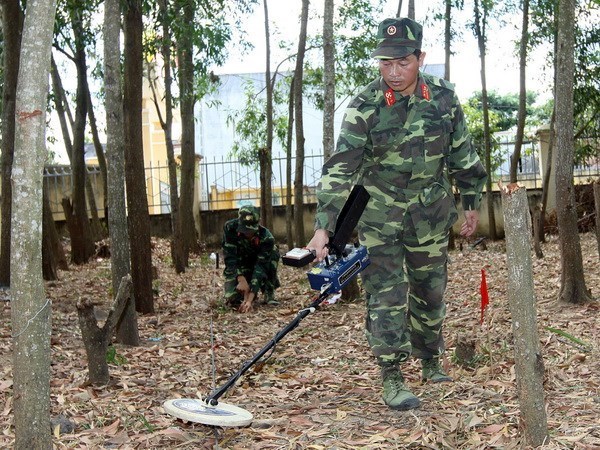
Sappers are
searching for war-left bombs and mines
Several
foreign-funded projects have been conducted in the central province of Quang
Tri over the past two decades, helping the locality to clear bombs and mines
left from war.
Quang
Tri is one of localities most affected by the aftermath of war, with 81
percent of the province’s total area polluted with unexploded ordnance
(UXO).
Statistics
from the provincial centre for overcoming bomb and mine consequences show
that by April 2018, bomb and mine accidents had killed 3,430 people and
injured 5,100 others, including many children.
Demining
projects in Quang Tri have been funded by many foreign agencies, including the
foreign ministries of Germany, the US and Norway, the Federal Ministry of
Economic Cooperation and Development of Germany, the UK’s Department for
International Development, Ireland’s development assistance fund, UNICEF and
the US organisation Peace Trees.
The
projects have helped clear 132 million sq.m of seriously polluted areas, and
safely handle more than 650,000 bombs, mines and other UXO.
More
than 350,000 people were provided with knowledge and skills to prevent UXO
accidents via the “Mine Risk Education (MRE)” programme.
Local
authorities have also paid attention to supporting local victims of war-era
UXO, helping them improve their living conditions and re-integrate into the
community.
Non-governmental
organisations have financed the building of 332 humanitarian houses, and
directly aided 215 UXO victims and their families.
Some
1,200 UXO victims who are living with disabilities were provided with medical
examination and prosthetics and other orthopedic instruments, while 50
disabled people and medical workers were trained in community-based
rehabilitation.
Nguyen
Duc Thien from the provincial centre for overcoming bomb and mine
consequences said demining projects have contributed to expanding safe land
area for production in the locality.
To
improve the work, the locality will set up a mine action centre, he said,
adding that Quang Tri hopes to receive greater support and resources for the
scheme.
VFF leader extends Chol Chnam Thmay greetings to Khmer people
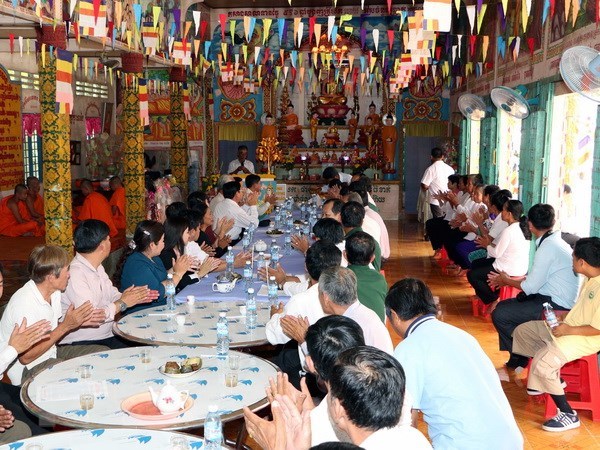
A Chol
Chnam Thmay celebration in KhemMapaPhia pagoda of Hau Giang province in
2017
President
of the Vietnam Fatherland Front (VFF) Central Committee Tran Thanh Man has
extended his best wishes to Khmer people nationwide on the occasion of their
New Year festival - Chol Chnam Thmay, which falls on April 14-16.
In
his letter sent to Khmer monks and people, Man wrote that Vietnam gained many
important achievements in the socio-economic, defence, security and
diplomatic fields in 2017 thanks to the efforts of the Party, army and
citizens.
The
material and spiritual lives of people, including the Khmer community, have
been improved.
He
appreciated the community’s efforts to follow the Party’s policies and the
State’s laws, as well as their participation in movements launched by the VFF
and their contributions to socio-economic development.
He
expressed his hope that Khmer people will be happier and contribute more to
national building and safeguarding.
Chol
Chnam Thmay is one of the most important festivals for Khmer people. It
usually lasts three days and is celebrated mostly in pagodas. The festival is
a demonstration of Khmer people’s aspirations, like many other ethnic groups,
to move on from the previous year’s misfortunes and look forward to a
promising new year.
Chợ Rẫy Hospital adopts advanced radiotherapy system

Chợ Rẫy
Hospital in HCM City yesterday (April 4) began using an advanced radiotherapy
system Versa HD that improves treatment precision, productivity and
efficiency.
Chợ
Rẫy Hospital in HCM City yesterday began using an advanced radiotherapy
system called Versa HD to improve treatment precision, productivity and
efficiency.
The
system, the most advanced radiotherapy in use in Việt Nam, is being used in
the delivery of stereotactic body radiotherapy (SBRT) and stereotactic
radiosurgery (SRS) in a conventional time slot, according to Nguyễn Trường
Sơn, director of the hospital.
The
system was funded with Official Development Assistance (ODA) from the
Austrian government to support the upgrading of equipment and machines at the
hospital’s oncology centre.
The
centre provides treatment for 800 to 1,000 patients every day, resulting in
patient overloading and long waiting times, which will be reduced with the
new system.
Every
year, there are 75,000 cancer-related deaths and around 150,000 people are
diagnosed with cancer. HCM City has 5,000-6,000 new cases of cancer every
year.
Government reclaims bonds used for Đèo Cả tunnel project
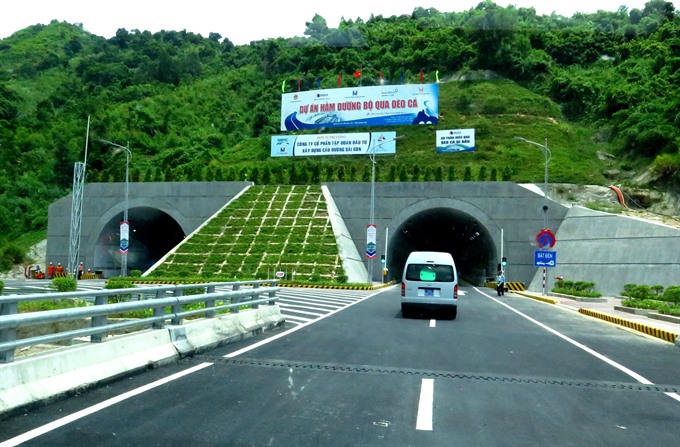
The
southern exit of the Đèo Cà tunnel on National Highway 1A linking the two
central provinces of Phú Yên and Khánh Hòa
Government
bonds used for the construction of the Đèo Cả tunnel project are to be
reclaimed under a decision by Prime Minister Nguyễn Xuân Phúc.
Under
the decision, VNĐ1.180 trillion (US$51.7 million) of the total VNĐ4.958
trillion ($217.2 million) in Government bonds allocated during the period of
2014-2016 by the Transport Ministry for the Đèo Cả Tunnel Project, including
those used to build the Cổ Mã Tunnel, will be collected by the Ministry of
Finance.
The
money claimed included VNĐ716.4 billion ($31.3 million) allocated for 2016
only.
The
reclaimed capital will be reserved for mid-term investment for the period of
2016-2020 under the authority of a resolution passed by the National Assembly
Standing Committee.
The
Ministry of Transport had to refund the money allocated in 2016 including the
money which was not yet disbursed, as well as the amount paid for ground
clearance and the resettlement of residents.
The
Transport Ministry was asked to review toll collection stations for the new
tunnel, as well as toll fees. They are also required to produce a report to
the Prime Minister calculating the effectiveness of money invested in the Đèo
Cả Project.
The
Đèo Cả Tunnel Project runs through the Cả Pass on National Highway 1A linking
the two central provinces of Phú Yên and Khánh Hòa. Construction began in
2012.
The
4.1-kilometre long Đèo Cả Tunnel is part of a 13.4-kilometre road project,
which also includes another tunnel, Cổ Mã, which is 500m long and opened to
traffic in 2015.
The
tunnel, built with an investment of VNĐ15.6 trillion (US$748 million), allows
vehicles to travel at a maximum speed of 80km per hour from Phú Yên
Province’s Hào Sơn Commune to Khánh Hòa Province’s Cổ Mã Commune.
Each
side of the road inside the tunnel has two 3.5m lanes, helping reduce the distance
between Phú Yên and Khánh Hòa provinces by 9km, and cutting off around 50
minutes of travel time. The new tunnel has put an end to commuter’s reliance
on the Cả Pass, which is dangerous during the rainy and typhoon seasons.
Toll
fees for using the tunnel have been collected since September 2017, and range
from VNĐ60,000 (US$2.64) to VNĐ288,000 (US$12.67), depending on the type of
vehicle used.
The
Đèo Cả Tunnel, which was put into operation in August last year, is the
second longest mountain road tunnel in the country, after the Hải Vân Tunnel,
which is 6.28 kilometres long and runs between Thừa Thiên in Huế Province and
Đà Nẵng City.
Urban design project on Belt Road No 3 publicised
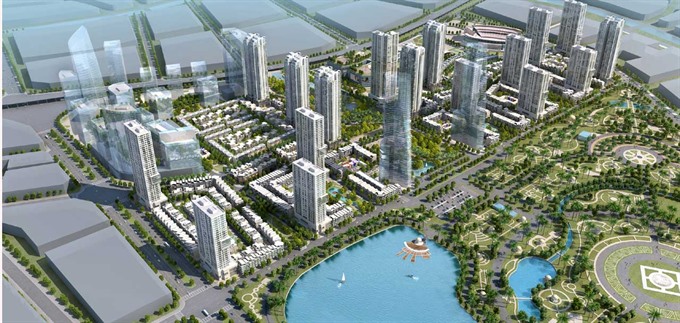
The Manor
Central Park developed by Bitexco Group along the Belt Road No 3. — Photo
Vietnamnet.vn
Buildings
in areas along Belt Road No 3 could rise up to 50 storeys, according to the
urban design project which was introduced by the Hà Nội Department of
Planning and Architecture on Tuesday.
The
project is for a 4.22km-long belt road running from Khuất Duy Tiến to Nguyễn
Xiển streets and covering 61.68ha.
On
Khuất Duy Tiến Street, the project encouraged the development of office and
residential housing, which could be 50 storeys in height.
For
the Thanh Xuân intersection where Khuất Duy Tiến, Nguyễn Trãi and Nguyễn Xiển
streets meet, mixed-use commercial projects were encouraged to exploit
advantages from the metro line.
On
Nguyễn Xiển Street, residential housing projects with an average height of
25-30 storeys were also suggested.
According
to the department, the setting up of urban design along the Belt Road 3 will
help renovate and coordinate the organisation of landscape on both sides of
the road to ensure a harmony between architectural space, urban landscape
between the existing construction and the new one, creating a modern, dynamic
and civilised Hà Nội urban centre.
Land
used in urban design along Ring Road 3 will be managed in accordance with the
zoning plan and detailed planning approved by the competent authority.
The
high-rise buildings on the southeast of Trần Duy Hưng Street and Thăng Long
Avenue, will be the highlight of the project.
Belt
Ring Road No 3 is an important road traffic route of Hà Nội. With a length of
about 65 km, it runs through such districts as Đông Anh, Bắc Từ Liêm, Nam Từ
Liêm, Cầu Giấy, Thanh Xuân, Thanh Trì, Hoàng Mai and Gia Lâm.
Landslides threaten lives of Chợ Gạo Canal residents
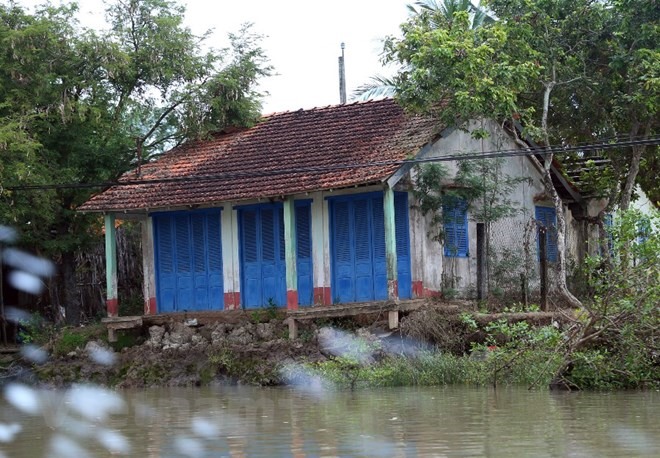
Hundreds of
households living along Chợ Gạo Canal in Tiền Giang Province are facing risk
of landslides and worry their houses could be swept away.
Hundreds
of families living along Chợ Gạo Canal in Mekong province of Tiền Giang fear
a landslide might destroy their homes any moment.
Chợ
Gạo Canal is an important waterway for transporting goods through ships from
HCM City to the Mekong Delta and vice versa. In the 2013-14 period, the
Ministry of Transport implemented the first phase of a project to dredge and
upgrade the canal.
However,
the second phase which was approved to be carried out in the 2016-2017 period
in the build, operate and transfer (BOT) format was suspended, as it could be
transferred to other form of investment.
Costing
VNĐ1.3 trillion (US$57.7 million), the project is aimed at upgrading a
28.6-km section of the canal.
The
slow implementation of the project’s second phase has affected the lives of
families living along the canal. The entire road system was completely
eroded, affecting the business of the local people.
The
areas most susceptible to erosion are concentrated in Bình Phục Nhứt, Bình
Phan and Xuân Đông communes.
Several
sections of dykes along the 10-km canal were eroded.
The
local people said the cause of the severe landslide was the large number of
boats passing Chợ Gạo every day, while the embankment kept degrading and was
not repaired on time.
Trần
Thị Thanh Hiền, a resident in Bình Phục Nhứt Commune, said the residents
lived in anxiety because the main road was damaged by the landslide.
Hiền,
whose house was at least a dozen metres away from the canal long ago, now
lives in fear of being swept away by the water, as erosion has brought the
house perilously close to the edge of the canal.
To
control the landslide, residents were using simple tools such as timber, sand
bags and steel wires, but a few days later, the road suffered more damage
through another landslide.
These
households cannot be shifted because they are waiting for support from the
Government to carry out the second phase of the project.
Lê
Văn Mỹ, chairman of People’s Committee of Chợ Gạo District, said more than
600 households had been affected by the poor implementation of the second
phase of the project.
The
local authorities have asked the Transport Ministry to conduct the second
phase quickly to help households lead a better life.
The
upgrade project will ease the traffic along the canal, preventing ships from
getting stuck in landslides and shallow water.
Sacked health workers calling for justice

As many as
137 health workers in the northern province of Lai Châu got sacked this month
after the province reviewed its employment policy.
As
many as 137 health workers in the northern province of Lai Châu got sacked
this month after the province reviewed its employment policy.
The
dismissal has caused concerns because the health workers signed labour
contracts of indefinite duration with healthcare centres and hospitals back
in 2011.
But
last year, the health workers reluctantly signed one-year labour contracts or
were told they had to leave their jobs.
Speaking
at a press briefing yesterday, spokesman of Lai Châu Province People’s
Committee Hà Trọng Hải said in 2011 the province’s Home Affairs and Health
departments temporarily employed 258 people to meet staff demand of local
healthcare sector.
But
just 80 of 258 temporary health employees passed the employment exam in
September, 2017. Those who failed or did not take the exam lost their jobs.
Director
of the province’s Health Department Nguyễn Văn Đối said the department wanted
to keep experienced staff and hoped that others could retake the exams and
work again.
Dismissed
health workers are very worried because of their sudden unemployment, and
submitted petitions to the province’s People’s Committee.
OVs in Germany offer support to Truong Sa
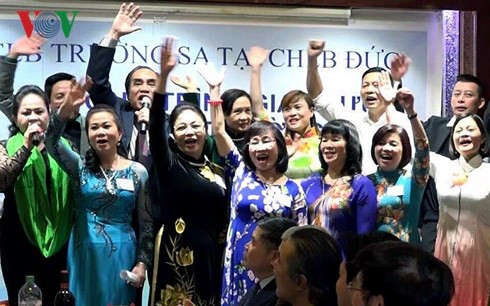
On
April 2, the Truong Sa (Spratly) Club in Germany held an exchange with people
who have visited Truong Sa archipelago and those who are planning a trip to
the archipelago in mid-April.
The
exchange was attended by Vietnamese Ambassador Doan Xuan Hung and
representatives of a selection of Vietnamese associations, unions, and
businesses who have been steadfast in their support of the Club’s activities
regarding Truong Sa over the past year.
In
addition to raising funds for Truong Sa, the exchange offered a chance for
Club members to brief the Vietnamese community on their recent work and
future plans.
In
its first year of operation, the Club has launched two fundraisers for the
children of soldiers stationed on the islands, encouraged students to write
letters to the islands’ soldiers, and organized arts performances and talks
with Vietnamese students and German and international friends on the topic of
Vietnam’s sovereignty over Hoang Sa (Paracel) and Truong Sa archipelagos.
Addressing
the event, Ambassador Doan Xuan Hung praised the Club members’ hard work over
the year and expressed his belief that activities organised by the club in
support of Truong Sa will attract the participation of more OVs in the
future.
On
the occasion, the Club encouraged OVs to help fund the planting of trees on
the islands in an effort to restore the abundant flora that was destroyed by
storms late last year.
Together
with 6,750 Euros raised at the event, the Club will hand over 10,000 Euros to
five people who are set to visit Truong Sa in mid-April, where they will
present the funds to Truong Sa residents and soldiers.
VNN
|
Thứ Sáu, 6 tháng 4, 2018
Đăng ký:
Đăng Nhận xét (Atom)
Không có nhận xét nào:
Đăng nhận xét